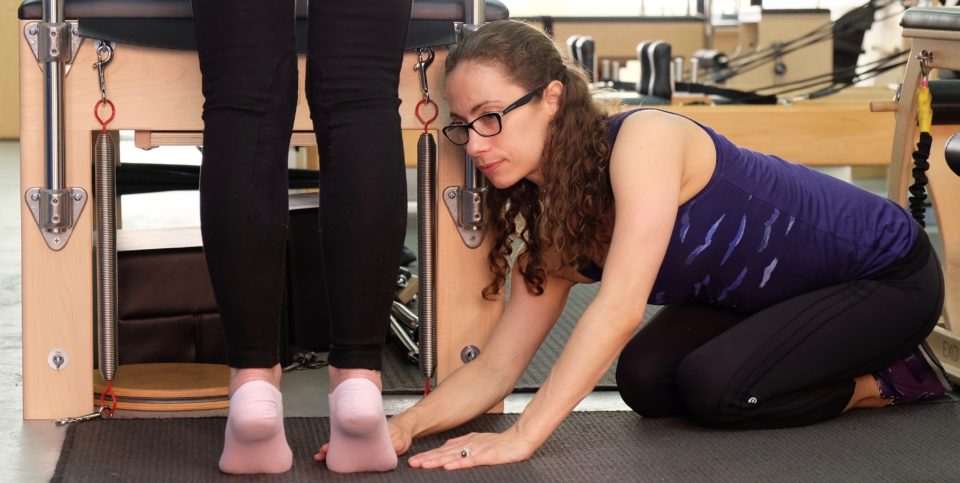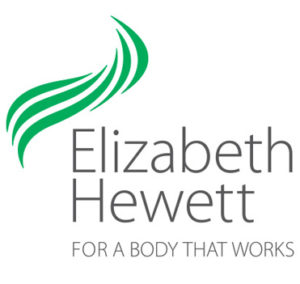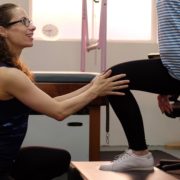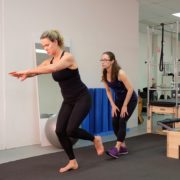Mind and muscle: how exercise physiology uses brain and body for great results

Julie* came to me in July 2017, as a referral from a remedial masseur. She had endured chronic back and neck pain for years, exacerbated by an avulsion tear to her lumbar spine as a result of a fall.
After two hip replacements, followed by another fall, more pain, and further spinal deterioration, she was told by a rehabilitation consultant that further surgery would likely be needed. She was reluctant, seeking help and education on how she could use exercise to improve her physical health.
Julie recently wrote to me about her experience to date:
‘From the moment I met her [Liz] I was impressed by her warmth, genuine interest and ability to grasp very quickly the impact that pain and resultant difficulty with everyday tasks were having on my quality of life …
‘Over the last three months Liz’s attention to detail and her ability to carefully explain to me the reasons behind her rationale for choosing certain movements and exercises has been extremely helpful. This has included her designing movements that will benefit my issues that are outside already developed programs; and with these I video Liz performing them in the studio. She then forwards them to me as part of my overall exercise program so I can then follow them at home.
‘In short it feels like a genuine partnership with Liz as encourager, guide and educator. She is an extremely committed and dedicated practitioner and I am very grateful to have her working alongside me.’
Julie’s story illustrates that allied health disciplines such as Pilates and exercise physiology can provide effective, complementary options to conventional medical care.
It also demonstrates that options communicated clearly and empathetically can educate on two levels: in the brain, and in the muscles, ligaments, tendons, and bones surrounding or affected by the injury.
Good exercise physiologists take education seriously, both their own and yours. When a conscientious and fully informed exercise physiologist works with you, they go beyond the immediate symptoms. They probe for health and lifestyle issues that may have an indirect or even unconnected effect on the injury site and your overall wellbeing.
Combined education and exercise therapy
My goal is to improve the way your body moves or works. I can achieve that better and more lastingly through a combination of education and therapeutic exercise, with the emphasis on education first.
It’s a parallel mind and body process in which your body learns to move in a different way. And I achieve my best results for you when I engage you mentally and physically in learning and change.
In Julie’s case, the long-term nature of the injury alerted me to the potential for further dysfunction in the muscles around not only the spine, but also the hip, ankle, and foot.
Rather than simply strengthening the muscles, we needed to work together to teach the muscles their correct function once more.
Involve the brain
And for that to happen, the brain had to be involved as well. Learning of this kind demands higher levels of concentration than most people expect when they perform the specific exercises designed to re-awaken dysfunctional muscles. Only when they operate as they should can we strengthen them to resume the roles they should have played all along.
Remedial practitioners, or educators?
Some allied health professionals see themselves as remedial practitioners only, helping you solve an injury or possible health issue. In my case, having explored all the factors that could affect your well-being, and individually tailored your exercise program, I continue to offer educational insights throughout our sessions.
I feel a powerful and personal connection to my calling as an exercise physiologist. As a life-long dancer, and a long term Pilates teacher and athlete, I’m profoundly aware of the benefits I’ve gained and continue to enjoy from an active physical life.
More than clinical services
Add the benefits I’ve received through my own allied health education, and I’m inspired to do more than deliver clinical services. I believe I have a duty to teach, coach, and act as a mentor to you in your quest for physical and mental wholeness.
I’m also fortunate in having had the benefit of association with some inspired teachers and mentors of my own. In additional to the usual professional development required to maintain professional registration and association memberships, I returned to university in 2012 to complete a Master in Exercise Science (Strength and Conditioning) degree. I also upgraded my Pilates qualifications to an Advanced Diploma and Diploma in Pilates Movement Therapy.
Over nearly 20 years, I’ve learned the science of health through movement from some of Australia’s most gifted dance and Pilates teachers as well as other health professionals. My eight years at The Australian Ballet School enabled me to take my knowledge of dance technique to a far deeper level as well as learning from the internationally renowned multidisciplinary dance medicine teams of The Australian Ballet School and The Australian Ballet.
The lesson I value most in my career to date is how to help people uncover the secrets of their body and its biomechanics themselves. I can think of no better or more permanent form of learning.
As a teacher and mentor, my greatest reward is watching you grow into or return to wellness through our collaborative efforts. My promise to you is to share the experience with empathy and compassion, and without evangelism or condescension.
For more insights into the connection between education and practice in exercise physiology, call Liz Hewett on 0466 314 645.
* Name changed to protect privacy.







